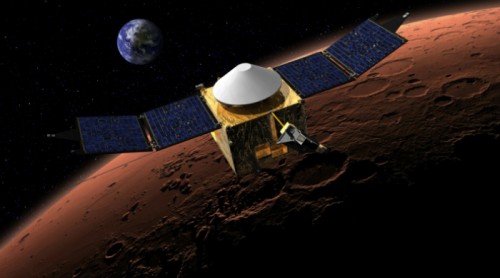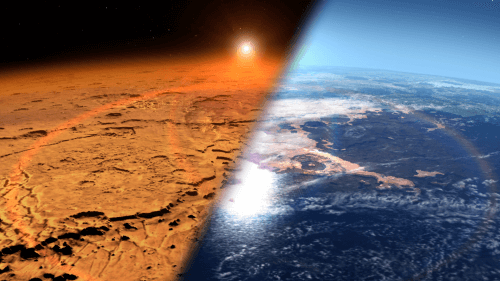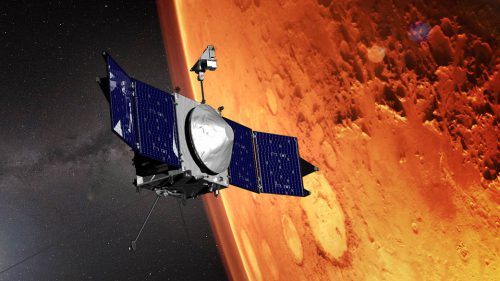Magnetic eruptions, atmospheric escape and the relationship between it and solar eruptions - all these were measured by the MAVEN spacecraft, data that helped to reconstruct the ancient atmosphere of Mars

introduction
On November 18.11.2013, 21.9.2014, the USA launched the MAVEN (Mars Atmosphere And Volatile Evolution) spacecraft to Mars. It was the first spacecraft launched to this planet without cameras. It was designed to enter orbit around it and focus on studying its atmosphere only. After a flight of ten months, on September 1, 2018, it entered orbit around it. The goals of the spacecraft were to study the upper atmosphere, to measure the loss of gases that escaped from the atmosphere over time and to provide answers regarding the development of the weather, to examine what remained of the magnetic field of Mars and what caused the loss of liquid water on the surface. The investigation of the magnetic field is of great importance in the study of the atmosphere and its interaction with the solar wind(2). Near the end of the source program, it was decided to extend its activity on Mars another year deep into the year 2018. What contributed to this decision were the success of the source program and the fuel stock that was in the spaceship's tanks, which could be enough for another ten years (2019). In 3, another option was tested. Slow down the flight speed and lower the flight altitude in XNUMX so that it will be possible to use a relay station for information that will be sent from all-terrain vehicles that will be sent to Mars in the future (XNUMX).
During normal mapping of Mars, measurements are made from a height of 6200 - 150 km above the ground. During deep measurements, one descends below the frigate of 125 km, which makes it possible to perform measurements throughout the entire upper atmosphere. This gap of 25 km allows measurements up to the top of the lower atmosphere. At this low altitude, the density of the atmosphere is 10 times higher than in the upper atmosphere. Here the connections between the components of the lower and upper atmosphere and space are measured. The first descent of the spacecraft was on February 18.2.2015, 10.2.2015 - February 4, XNUMX. In the first three days, the frigate was lowered. This was followed by a series of observations of five rounds of five days each. The goal was to sample the atmosphere at different longitudes, which allowed almost complete coverage of Mars (XNUMX).
the wind of the sun
The ultraviolet cameras photographed thin coronas of oxygen, hydrogen and carbon surrounding Mars. It is estimated that the energetic particles from the sun are probably the main cause of the loss of the atmosphere. After their long journey through space, upon reaching Mars these particles, in particular the protons, invest their energy in the upper atmosphere. Such an event occurs once every few weeks. The hydrogen and oxygen coronas are the thin layers of the outer edge of the upper atmosphere where the atoms that were part of the carbon dioxide molecules and water molecules near the ground escape into space (5).
During its observations, the spacecraft discovered a stream of solar wind particles that are not deflected to the side during their entry into the atmosphere, but penetrate deeply into the upper atmosphere and ionosphere. The interaction with the upper atmosphere makes these particles neutral and penetrates the layers of the lower atmosphere. Deep in the ionosphere these particles turn back into ions (6).
The measurements of the upper atmosphere have shown that the ion escape velocity is enhanced during solar flares, which could imply that atmospheric loss is significant in the history of Mars.

Glamor
The glow phenomenon that on Earth appears at the poles also exists on Mars, but here it is found in different places and is created by the remnants of the magnetic field of Mars (7). The observations made so far testified to the presence of the aurora in the Northern Hemisphere up to the equator. Ten years ago, the European Mars spacecraft Mars Express, during its ultraviolet measurements in the southern hemisphere, discovered a glow in a configuration that received the name "magnetic umbrellas". The reason for this name is that magnetic fields erupt from the ground like mushrooms. The outbreaks are random and in different places. The aurora is created when barrages of energetic particles from the sun hit the upper atmosphere. Following this impact, they create a glow at a height that is less than 100 km from the ground. The oxygen in the atmosphere is the source of the color of the glow. It is the excited oxygen atoms that create the green light (8).
In the observations it was found that a new type of glow appears during most of the day only and is difficult to observe and identify. It turned out that the protons on Mars do on Mars what the electrons do on Earth in creating the glow. There are cases when the ultraviolet light coming from the hydrogen in the upper atmosphere inexplicably becomes bright for a few hours and then these events become bright (brightening). The researchers noticed that the SWIA device (solar wind ion analyzer) measures amplified protons of the solar wind. On his face this glow is impossible. How do these protons pass through the bow shock of Mars which is a magnetic obstacle that usually deflects charged particles of the solar wind surrounding Mars and how do they release light since the atoms need electrons to do this? It turned out that when the protons approach Mars together with the solar wind they become neutral atoms. In doing so, they steal electrons from the other side of a large hydrogen cloud that surrounds Mars.
The shock wave can only tilt charged particles so that these neutral atoms continue their straight motion. When these fast atomic particles hit the atmosphere, some of their energy is released in ultraviolet light and is seen by instruments such as the IUVS on the spacecraft. A single atom can collide with molecules in the upper atmosphere hundreds of times before it slows down and stops killing protons in ultraviolet light. Proton glow also appears on Earth, but not in the same form as on Mars, this is a significant difference that makes the difference. Earth's magnetic field tilts the solar wind at a greater angle than on Mars. On Earth proton glow occurs only in small areas and near the poles. On Mars it can occur anywhere(9).
magnetic field
The importance of studying the magnetic field of Mars lies in the fact that Mars lost its magnetic field billions of years ago, which allowed the solar wind to tear its atmosphere and dry it out. What remains today of its magnetic field are local fields in the crust, remnants of the global magnetic field. This condition can create pockets of atmosphere that are protected from the solar wind and other areas are left vulnerable. Measuring these segments of the magnetic field of Mars will also allow obtaining a broad view of the atmosphere as a whole (1).

atmosphere
By measuring the upper atmosphere, one examines how the atoms that make it up escape into space. These measurements support the currently accepted view that the upper atmosphere is held by the weak gravity of Mars. Ultraviolet measurements also allow mapping of the ozone in the atmosphere by detecting the absorption of ultraviolet sunlight by its molecules. This way you get full coverage of Mars. It is a type of measurement that until today has only been possible for measurements of the Earth (5).
The spacecraft's instruments measured explosions of gases in ions and neutral configurations and they discovered very defined structures in the upper atmosphere and the biosphere which is different from the lower atmosphere where the gases are mixed together. The changes in these compensations over time will allow the development of new insights into the physics and chemistry of this region and have provided significant information regarding the weather in the upper atmosphere. This type of measurement has not been done by previous spacecraft launched to Mars. New insights into the way gases escape from the atmosphere. A few hours after the STATIC (Suprathermal And Thermal Ion Composition) device started working, it discovered a polar plume of ions escaping from the planet. This type of measurement allows tracking the escape rate of atmospheric gases into space. It turned out that energetically excited ions escape the gravitational pull of Mars as they move along the plume that extends far beyond Mars (6).
In two penetrations into the upper atmosphere made by the spacecraft to measure the nature of the ionosphere, a large vertical thermal cascade was noticed. The accumulated information indicated a stable mixture of carbon dioxide, argon and nitrogen dioxide and larger than expected amounts of oxygen. The density of these elements at an altitude of 200 km changes substantially when the spacecraft completes one lap. According to the researchers' assessment, this change is the result of a gravity wave interacting with small-scale agitation processes occurring from below. Changes in the magnetic field and the ion layers raise the possibility that the Martian crust also contributes to the magnetic field (7). It turned out that molecules and atoms escape from the atmosphere at a high rate when explosions occur on the sun (coronal mass ejections) that pass by Mars and create formations of magnetic poles that can reach a length of 5000 km and along the way sweep planetary ions into space(10). Mars loses 100 grams of atmosphere every hour (11).
After investigating the upper atmosphere for one Martian year, it became clear that the escape of water is not uniform and not always smooth. It was found that there are ups and downs in the rate of hydrogen escape. The escape rate was highest when Mars was in its perigee relative to the Sun and it fell when Mars was in its epigea. The rate of hydrogen escape varies dramatically up to 10 times its maximum. The hydrogen in the upper atmosphere comes from water vapor. The water in the atmosphere can be broken down by sunlight releasing the hydrogen and oxygen. The escape rate of hydrogen can be caused by seasonal effects and the solar wind. (12).
It turned out that there are charged metal atoms in the upper atmosphere. Since metallic ions have a long life span it was estimated that they are transported to great distances from their original region by neutral winds and magnetic fields. They can be used as a measure of movement in the ionosphere. In follow-up tests, it was estimated that the source of the metals is a shower of tiny, high-speed meteorites that hit the atmosphere and evaporate. The metal atoms discovered are iron. magnesium and sodium. The metal ions behave differently from those in the Earth's atmosphere (13). The resulting impression that the origin of the metal atoms is from both sources.
dust
Dust was discovered at altitudes between 1000-150 km. There is no known process that can raise a concentration of particles from the ground to such a high height. Based on the size of the particles 5-1 nanometers and their concentration in the air, the possibility that they originated from the moons of Mars was ruled out. The conclusion they reached is that their origin is between the stars (7).
Sources
- Claire De Saravia – “Measuring Mars: The MAVEN Magnetometer” 28.3.2013
http://www.marsdaily.com/reports/Measuring_Mars_The_MAVEN_ Magnetometer_999.html
- Tomaz Nowakouski - "MAVEN spacecraft gears up to observe dust storm on Mars" 23.8.2016
http://www.marsdaily.com/reports/MAVEN_Spacecraft_Gears_Up_Observe_Dust_ Storm_ On_ Mars_999.html
- 3. Nancy Jones – NASAS's MAVEN selfie marks four years in orbit at Mars” 24.9.2018
http://www.marsdaily.com/reports/NASAS’s_MAVEN_Selfie_Marks_Four_Years_In_ Orbit_At_ Mars_999.html
- Nancy Neal Jones - "MAVEN completes first deep dip campaign" 20.2.2015
http://www.marsdaily.com/reports/MAVEN_Completes_First_Deep_Dip_Campaign_999.html
- "MAVEN spacecraft's first look at Mars holds surprises" 16.10.2014
http://www.marsdaily.com/reports/MAVEN_Spacecraft’s_First_look_At_Mars_ Holds_ Surprises_999.html
- "MAVEN identifies links in chain leading to Mars atmospheric loss" 16.2.2014
- "Delving into the atmosphere of Mars" 6.11.2015
http://www.marsdaily.com/reports/Delving_Into_The_Atmosphere_Of_Mars_999.html
- Tony Phillips - "Auroras on Mars" 15.5.2015
http://www.marsdaily.com/reports/Auroras_On_Mars_999.html
- Bill Stigerwald, Nancy Jones – "NASA's MAVEN spacecraft finds that stolen electrons enable unusual aurora on Mars" 24.7.2018
http://www.marsdaily.com/reports/NASAs_MAVEN_Spacecraft_Finds_That_Detector_ Stolen _Electrons _ Enable _Unusual_Aurora_On_Mars_999.html
- Stuart Gary – “On Mars. Aurora takes place just anywhere, new MAVEN data reveals" 6.11.2015
- Christopher Croskett – "A defenseless mars is losing its atmosphere" 11.11.2015
https://www.sciencenews.org/article/a-defenseless-mars-is-losing-its-atmosphere
12. "MAVEN mission observes ups and downs of water escape from Mars" 21.10.2016
- "NASA's MAVEN reveals Mars has metal in the atmosphere" 12.4.2017
http://www.marsdaily.com/reports/NASAs_MAVEN_Reveals_Mars_Has_Metal_In_The_ Atmosphere_999.html

4 תגובות
Interesting article, you should just correct one small detail regarding the Hebrew. I assume that the intention was to spread and not to explode
Does anyone know about the types of elements Maven's sensors are able to detect in the Martian atmosphere?
Is it possible that there are other gases there that are not in the detection range of the sensors, and specifically regarding isotopes of xenon gas?
Thanks.
Invested article. Thanks
How does Elon Musk plan to start the magnetic field (and the lack of which makes life impossible)?